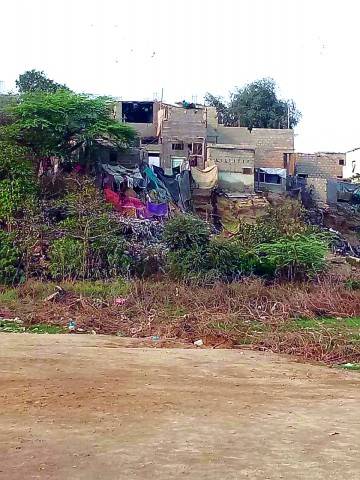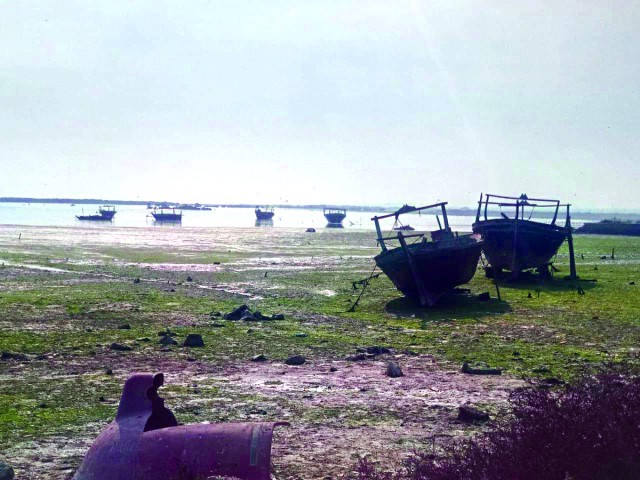
Wandering outside the Bengali Para, Karachi-Malir, trying to find a street that would take us inside the Katchi Abadi (informal settlement), we met a young man in his early 20s, about 5.5 feet tall, of Bengali origin, standing still with his eyes stuck on a particular point in the sea. “I am waiting for my father, he will be returning home soon from that end,” he told us. We inquired why he was waiting there, why not cross the road and go to the other end to receive his father. We learned that it was because he did not have a CNIC (computerized national identity card). So, if he walked to the other end of the road alone, police patrolling the area would stop him and ask him to prove his identity by showing an identification documentation. Upon failing to produce the required document, he would have no option but to bribe the policeman. The economic life of Jamshed* and his family shows the deep-rooted formal and informal exploitation that the residents of Katchi Abadis face every day.
Jamshed’s father, along with three other members of the community, share a boat and go to the sea to catch fish. While some people can afford to buy nets for catching a large number of fish, Jamshed’s father and colleagues can only afford to rely on hooks. Sometimes they go early in the morning and return before sunset while other times, they spend many days in the sea before returning with fish to sell. Spending time in deep-seas also puts their lives at risk of storms. Although Jamshed’s father has been able to avoid such life-threatening events so far, he knows people who have lost relatives to the sea.

After putting themselves at such great risks, Jamshed’s father and colleagues sell the fish to a middle-man at a price of Rs150 per kg. Jamshed himself catches crabs and shrimps. He also sells the seafood items to a middle-man. The price ranges from Rs150 to Rs500 depending on the weight of the product. The issue of CNICs severely restricts their mobility and access to larger markets while the dependence on middle-men only strengthens the exploitative structures of the free market.
Jamshed’s father has been smart to diversify the sources of income for his family by requiring Jamshed’s brothers not to join the seafood market but become tailors for the Bengali Para residents. In total, the four earning members of the family make about 20,000 to 25,000 rupees per month for a family of ten.
While at the private level, the middle-men of the market are looting Jamshed and his family, the public service providing entity, the government has its own ways of plundering. Their Para gets water supply one hour per week. At times, they lose electricity power right at that hour so they end up having to wait for another week to get water. They still pay the bills.
The question of education is also linked with mobility issues. While formal public and private schools are available in the Bengali Para for up to matriculation, what good is the investment if Jamshed and younger siblings would still be restricted to their Para due to lack of identity cards? The only rational investment for the family appears in the ‘opiate of the masses’ i.e., religion. Therefore, all family members are devoted to religious education in madrassas. To see religious buildings so well-developed amongst the poorly, and at times only semi constructed houses of Katchi Abadis explains the level of intoxicating effect of religion over the masses.
The number of hours and the level of energies that Jamshed, his family and many like him are putting in to contribute to the economy, when compared with the remunerations that they receive from private employers and the facilities and services that they receive from the government in their society point to the public-private partnership of exploitation that Katchi Abadi residents have to live through on every day basis.

The city of lights, Karachi, fails to illuminate the lives of its Katchi Abadi residents. Karachi has estimated 600 to 700 Katchi Abadis, accommodating over 35 percent population of the provincial capital. Katchi Abadis appeared as a result of informal power relations between the ruling elite and the subjects, and overtime the formal institutions synced with the informal in a way that Katchi Abadis became not just a part, but a pillar of the urban structure, too. Their presence serves the capitalist elite in various ways. In a nutshell, Katchi Abadis represent an ever-growing class of exploited persons facing severe challenges of recognition, rights and autonomy. It is high time to rethink and restructure cities with the basic motto of giving residents recognition and right to the city instead of continuing to view cities as engines of growth without any regard for humans and humanity.
Pseudonym has been used to protect the privacy of the individual.
The authors are researchers with ASER Pakistan at Idara-e-Taleem-o-Aagahi (ITA)
Jamshed’s father, along with three other members of the community, share a boat and go to the sea to catch fish. While some people can afford to buy nets for catching a large number of fish, Jamshed’s father and colleagues can only afford to rely on hooks. Sometimes they go early in the morning and return before sunset while other times, they spend many days in the sea before returning with fish to sell. Spending time in deep-seas also puts their lives at risk of storms. Although Jamshed’s father has been able to avoid such life-threatening events so far, he knows people who have lost relatives to the sea.

After putting themselves at such great risks, Jamshed’s father and colleagues sell the fish to a middle-man at a price of Rs150 per kg. Jamshed himself catches crabs and shrimps. He also sells the seafood items to a middle-man. The price ranges from Rs150 to Rs500 depending on the weight of the product. The issue of CNICs severely restricts their mobility and access to larger markets while the dependence on middle-men only strengthens the exploitative structures of the free market.
Jamshed’s father has been smart to diversify the sources of income for his family by requiring Jamshed’s brothers not to join the seafood market but become tailors for the Bengali Para residents. In total, the four earning members of the family make about 20,000 to 25,000 rupees per month for a family of ten.
While at the private level, the middle-men of the market are looting Jamshed and his family, the public service providing entity, the government has its own ways of plundering. Their Para gets water supply one hour per week. At times, they lose electricity power right at that hour so they end up having to wait for another week to get water. They still pay the bills.
Karachi has estimated 600 to 700 Katchi Abadis, accommodating over 35 percent population of the provincial capital
The question of education is also linked with mobility issues. While formal public and private schools are available in the Bengali Para for up to matriculation, what good is the investment if Jamshed and younger siblings would still be restricted to their Para due to lack of identity cards? The only rational investment for the family appears in the ‘opiate of the masses’ i.e., religion. Therefore, all family members are devoted to religious education in madrassas. To see religious buildings so well-developed amongst the poorly, and at times only semi constructed houses of Katchi Abadis explains the level of intoxicating effect of religion over the masses.
The number of hours and the level of energies that Jamshed, his family and many like him are putting in to contribute to the economy, when compared with the remunerations that they receive from private employers and the facilities and services that they receive from the government in their society point to the public-private partnership of exploitation that Katchi Abadi residents have to live through on every day basis.

The city of lights, Karachi, fails to illuminate the lives of its Katchi Abadi residents. Karachi has estimated 600 to 700 Katchi Abadis, accommodating over 35 percent population of the provincial capital. Katchi Abadis appeared as a result of informal power relations between the ruling elite and the subjects, and overtime the formal institutions synced with the informal in a way that Katchi Abadis became not just a part, but a pillar of the urban structure, too. Their presence serves the capitalist elite in various ways. In a nutshell, Katchi Abadis represent an ever-growing class of exploited persons facing severe challenges of recognition, rights and autonomy. It is high time to rethink and restructure cities with the basic motto of giving residents recognition and right to the city instead of continuing to view cities as engines of growth without any regard for humans and humanity.
Pseudonym has been used to protect the privacy of the individual.
The authors are researchers with ASER Pakistan at Idara-e-Taleem-o-Aagahi (ITA)

